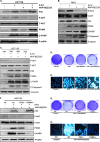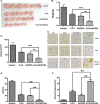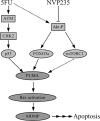PUMA mediates the combinational therapy of 5-FU and NVP-BEZ235 in colon cancer
- PMID: 25965911
- PMCID: PMC4546474
- DOI: 10.18632/oncotarget.3775
PUMA mediates the combinational therapy of 5-FU and NVP-BEZ235 in colon cancer
Abstract
Colon cancer is the third most common cancer in humans which has a high mortality rate, and 5-Fluorouracil (5-FU) is one of the most widely used drugs in colon cancer therapy. However, acquired chemoresistance is becoming the major challenges for patients, and the molecular mechanism underlying the development of 5-FU resistance is still poorly understood. In this study, a newly designed therapy in combination with 5-FU and NVP-BEZ235 in colon cancer cells (HCT-116 and RKO) was established, to investigate the mechanism of 5-FU resistance and optimize drug therapy to improve outcome for patients. Our results show 5-FU induced cell apoptosis through p53/PUMA pathway, with aberrant Akt activation, which may well explain the mechanism of 5-FU resistance. NVP-BEZ235 effectively up-regulated PUMA expression, mainly through inactivation of PI3K/Akt and activation of FOXO3a, leading to cell apoptosis even in the p53-/- HCT-116 cells. Combination treatment of 5-FU and NVP-BEZ235 further increased cell apoptosis in a PUMA/Bax dependent manner. Moreover, significantly enhanced anti-tumor effects were observed in combination treatment in vivo. Together, these results demonstrated that the combination treatment of 5-FU and NVP-BEZ235 caused PUMA-dependent tumor suppression both in vitro and in vivo, which may promise a more effective strategy for colon cancer therapy.
Keywords: Akt; NVP-BEZ235; PUMA; colon cancer; p53.
Conflict of interest statement
The authors declare no conflicts of interest.
Figures








Similar articles
-
Pazopanib, a novel multi-kinase inhibitor, shows potent antitumor activity in colon cancer through PUMA-mediated apoptosis.Oncotarget. 2017 Jan 10;8(2):3289-3303. doi: 10.18632/oncotarget.13753. Oncotarget. 2017. PMID: 27924057 Free PMC article.
-
MEK5/ERK5 signaling inhibition increases colon cancer cell sensitivity to 5-fluorouracil through a p53-dependent mechanism.Oncotarget. 2016 Jun 7;7(23):34322-40. doi: 10.18632/oncotarget.9107. Oncotarget. 2016. PMID: 27144434 Free PMC article.
-
Idelalisib induces PUMA-dependent apoptosis in colon cancer cells.Oncotarget. 2017 Jan 24;8(4):6102-6113. doi: 10.18632/oncotarget.14043. Oncotarget. 2017. PMID: 28008149 Free PMC article.
-
Cabozantinib induces PUMA-dependent apoptosis in colon cancer cells via AKT/GSK-3β/NF-κB signaling pathway.Cancer Gene Ther. 2020 May;27(5):368-377. doi: 10.1038/s41417-019-0098-6. Epub 2019 Jun 11. Cancer Gene Ther. 2020. Retraction in: Cancer Gene Ther. 2022 Nov;29(11):1806. doi: 10.1038/s41417-022-00545-3. PMID: 31182761 Free PMC article. Retracted.
-
Melatonin and 5-fluorouracil combination chemotherapy: opportunities and efficacy in cancer therapy.Cell Commun Signal. 2023 Feb 9;21(1):33. doi: 10.1186/s12964-023-01047-x. Cell Commun Signal. 2023. PMID: 36759799 Free PMC article. Review.
Cited by
-
Pazopanib, a novel multi-kinase inhibitor, shows potent antitumor activity in colon cancer through PUMA-mediated apoptosis.Oncotarget. 2017 Jan 10;8(2):3289-3303. doi: 10.18632/oncotarget.13753. Oncotarget. 2017. PMID: 27924057 Free PMC article.
-
The FOXO3-FOXM1 axis: A key cancer drug target and a modulator of cancer drug resistance.Semin Cancer Biol. 2018 Jun;50:77-89. doi: 10.1016/j.semcancer.2017.11.018. Epub 2017 Nov 24. Semin Cancer Biol. 2018. PMID: 29180117 Free PMC article. Review.
-
The Role of p53 Dysfunction in Colorectal Cancer and Its Implication for Therapy.Cancers (Basel). 2021 May 11;13(10):2296. doi: 10.3390/cancers13102296. Cancers (Basel). 2021. PMID: 34064974 Free PMC article. Review.
-
Role of the long non-coding RNAs in regulation of Gemcitabine response in tumor cells.Cancer Cell Int. 2023 Aug 14;23(1):168. doi: 10.1186/s12935-023-03004-7. Cancer Cell Int. 2023. PMID: 37580768 Free PMC article. Review.
-
PRODeepSyn: predicting anticancer synergistic drug combinations by embedding cell lines with protein-protein interaction network.Brief Bioinform. 2022 Mar 10;23(2):bbab587. doi: 10.1093/bib/bbab587. Brief Bioinform. 2022. PMID: 35043159 Free PMC article.
References
-
- Siegel R, Naishadham D, Jemal A. Cancer statistics, 2010. CA: a cancer journal for clinicians. 2012;62:10–29. - PubMed
-
- Longley DB, Harkin DP, Johnston PG. 5-fluorouracil: mechanisms of action and clinical strategies. Nature reviews Cancer. 2003;3:330–338. - PubMed
-
- Tournigand C, Andre T, Achille E, Lledo G, Flesh M, Mery-Mignard D, Quinaux E, Couteau C, Buyse M, Ganem G, Landi B, Colin P, Louvet C, de Gramont A. FOLFIRI followed by FOLFOX6 or the reverse sequence in advanced colorectal cancer: a randomized GERCOR study. Journal of clinical oncology : official journal of the American Society of Clinical Oncology. 2004;22:229–237. - PubMed
Publication types
MeSH terms
Substances
LinkOut - more resources
Full Text Sources
Other Literature Sources
Research Materials
Miscellaneous

